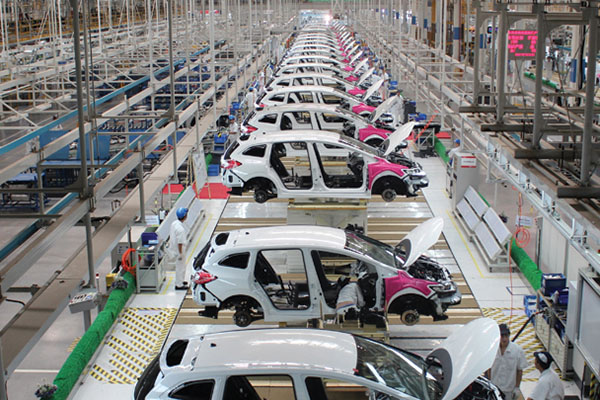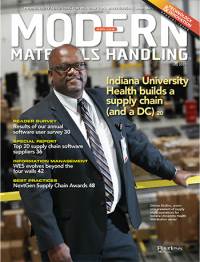Materials handling in automotive hits an inflection point
Despite all the technology in our cars, automakers are only starting to change how they build them. The next five years should be interesting, as automakers respond to outside and inside pressures to up their game.
Just coming off the Fourth of July weekend in 2011, Kiplinger.com published an article titled “10 features your car will have by 2020.” Well, we’re almost there, and you might wonder how accurate the article was.
Only one of the 10 features mentioned have eluded auto companies as of 2019—vehicle-to-vehicle communications. But we all know that is coming, especially with autonomous vehicles. As to the other projections, Kiplinger nailed it, identifying major developments from “warnings galore” to “eyes all around” and “advanced engines.”
Which brings up a parallel question: How is materials handling likely to change on assembly lines and at Tier 1 suppliers in the coming years? After speaking with several leading suppliers, changes in the technology used to build cars is on a slower track than the changes in technology offered in cars.
“Change is not going to happen overnight,” explains Mike Romano, president and CEO of Toyota Advanced Logistics North America.
Romano is not alone in that assessment. Several industry experts agreed in their own ways.
“Automotive is a mature supply chain that needs some overhauls,” says Scott Krebs, marketing manager at Orbis Corp.
“There needs to be a mindset change about materials handling systems feeding the line,” says Bob Hoffman, senior director of systems design at Swisslog.
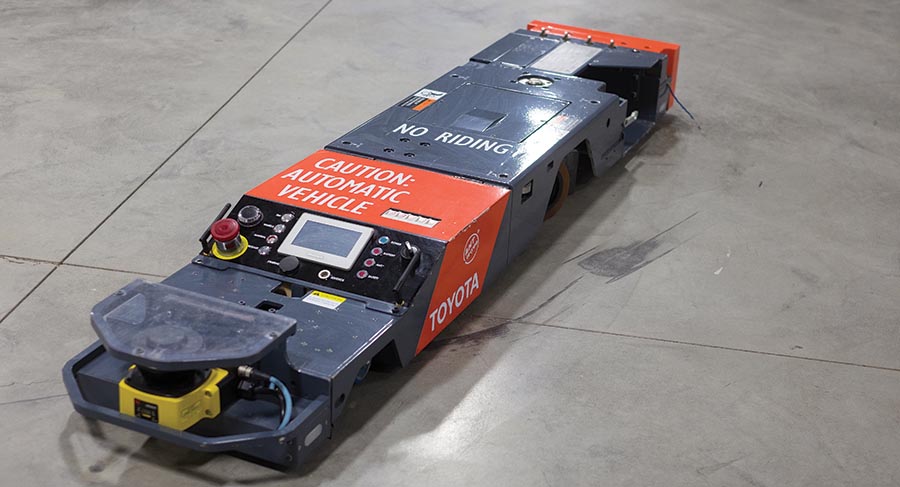
Automakers are becoming more comfortable with AGVs, including very low-profile ones that tunnel under carts and move them to their destinations.
Those and other comments don’t mean change is not coming, just that it is gently underway and will be gradual rather than revolutionary.
“Change in materials handling in automotive is more of a future thing than something that is already happening,” explains Greg Pachuta, sales manager at JBT. As evidence, he points out that use of automatic guided vehicles (AGVs) in particular has increased in the past five to 10 years. However, he foresees an even greater rate of change in the next five years.
By the way, Pachuta’s five-year horizon matches up with those of others for key aspects of materials handling change in automotive. Which is curious given the consumer and manufacturing pressures on the industry right now.
Pressures on automakers
Several keywords are important here. They include consumer demands, competition, flexibility and connectivity.
“Go back just a few years, and the Ford F-150 trucks coming down the line were pretty much identical,” says Krebs. “Today, almost every F-150 has different features ranging from sunroofs to sound systems. That shift alone is forcing automakers to increase SKUs that are lineside at any given moment.”
Consumers are forcing automakers to become more flexible in manufacturing as they demand their own mix of car features. It’s also happening on the product front.
We are all aware of the demise of the sedan and the crowning of the SUV and trucks as the mainstay of auto companies. This creates its own pressure cooker for companies to differentiate themselves, yet be nimble on build schedules.
There’s also the matter of flexibility in how the line operates. David Musch, regional manager at Bastian Solutions, notes, for instance, a shift from fixed conveyors to AGVs.
Mobile robots, or cobots, are also adding new flexibility unmatched by traditional transfer lifters, explains Satoru Otani, Daifuku’s senior vice president. He and his colleague, Randy Lovejoy, account executive, explain that robots offer more range of motion that can be easily reprogrammed for maximum flexibility and ergonomic benefit.
That triumvirate—consumer demands, competition and flexibility—have created an unprecedented need for connectivity throughout supply chains, explains Irving Suero, account executive at DMW&H. “Connectivity should tap into everything from tariffs to the day’s build schedule. People increasingly have to be in the loop as it morphs to changing conditions and demands. Otherwise, the line is suddenly short parts or building what won’t sell,” says Suero.
It’s worth noting that due to the relatively high pay of automotive jobs, carmakers are not having a difficult time finding enough workers. Quite simply, labor is not an issue in this arena, unlike most every other aspect of the workforce.
Change is underway
Sometimes change in one aspect of an operation can’t happen until there’s a change someplace else. And, that is certainly the case here.
“In the past two years, I’ve noticed two important shifts in their approach,” explains Musch. “Traditionally, we would talk with an engineer or two about upcoming changes. Now we talk to a cross-functional team. It includes operations and assembly people, maintenance, product design and IT. The team approach clearly signals a shift but perhaps the biggest one is coming from the IT people. They have traditionally known one word and were prone to repeating it: no, no, no. Now they want to know how we can make this work. That’s a huge shift.” He estimates that more than half of auto plants use the team approach today.
Another is the time allowed for model changeovers, says Musch. Traditionally, materials handling suppliers worked on a six-month timeline. Today, that has been shortened to two months, he says. Clearly, auto companies are beginning to feel a sense of urgency to change how they manage the line.
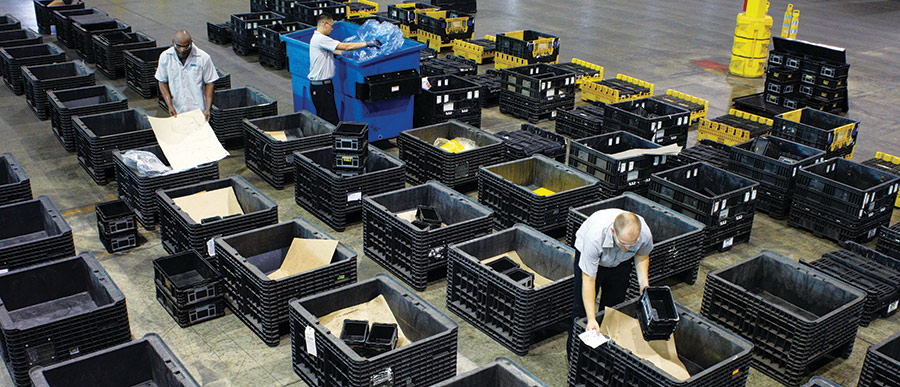
Reusable packaging reigns, but that requires sophisticated tracking and inspection of containers to maximize efficiency.
What’s up with AGVs?
One of the most important recent trends has been to broader use of AGVs, as Pachuta mentioned earlier. “As auto companies develop their own autonomous vehicles for the highway, they are becoming more comfortable with AGVs in the plant,” he says.
That bodes well for AGVs of many types. AGVs using laser guidance and tape guidance dominate today. Some vehicles are smaller carts that act as tuggers, bringing product to the line. Others have forks for handling loads often staged in racks. Still others are very low-profile vehicles. Tunneling vehicles are about 6 inches tall and tunnel under a cart. A pin on the AGV locks into the underside of the cart and moves it to its destination. Cobots, robots on top of AGVs, are still another variation but are probably the least widely used of all guided vehicles today.
Pachuta notes that the size of AGV systems is changing, too. Ten years ago, the average system was only three to six vehicles and used in small pockets of the plant. That has moved onto systems of 20 to 40 vehicles placed most anywhere in the facility.
Guidance systems are most likely to undergo significant changes going forward. The general expectation is that LIDAR (light detection and ranging) guided vehicles are the future. Rather than following tape or lasers, LIDAR AGVs use an on-board computer and a map of the facility to select, in real time, a path to a pre-set destination. The technology is used commercially elsewhere than automotive right now. In addition to AGVs, LIDAR guidance can also be used with automated lift trucks. But that’s even further in the future.
Automated lift trucks, a close cousin of AGVs, are not as widely used in automotive. Raymond’s Chris Merta, manager of automation applications, says his company has sold many automated tow tractors, also known as tuggers, to Tier 1 and 2 suppliers of parts and kits.
Additionally, there are, according to JBT’s Pachuta, some retrofitted forked lift trucks using his company’s kits in auto plants. That said, don’t underestimate the potential for automated lift trucks.
On the line itself, skillets continue to be popular. These powered carriers that workers ride on as they work move auto assemblies along the line as an alternative to power-and-free and overhead power-and-free conveyors. Lovejoy and Otani of Diafuku say skillets are becoming more popular since they reduce the walking required of workers, lift assemblies to ergonomic heights and are extremely quiet, an appreciated feature in noisy auto plants.
Other developments of note
When it comes to packaging, automotive has standardized on reusables, says Orbis’ Krebs. That goes for plastic as well as metal packaging. The parts transported need to be routed from the suppliers to the automaker and back. Doing that efficiently requires good tracking of reusables, inspection of them and efficient logistics, explains Krebs.
Both radio frequency identification (RFID) and Bluetooth technologies (both part of the trend to connectivity) are used to track packaging as well as the parts inside. On the return side, the packaging requires inspection for damage before release again. “We treat the returnable as an asset,” says Krebs.
While tracking and inspection are important, logistics, the most costly aspect, are even more important. “We want to optimize truck routes and other logistics to ensure maximum cost efficiency. Just capturing data is not the solution. Someone needs to analyze the data and put it to use,” says Krebs.
For instance, a standard 53-foot truck has positions for 26 standard bulk containers. Orbis recently released a new container design that maintains internal capacity of the containers but allows 28 positions on a truck. “This means more parts per truck. Combine the increased load with more efficient truck routing, and the logistics of reusables full of parts and assemblies is optimized. At least for now,” says Krebs.
Every auto plant is full of parts as they make their way to the line. Parts flow is highly dynamic with little sitting anyplace for long. And most of that sits in open racks for pickup by lift trucks or AGVs.
But as Swisslog’s Hoffman points out, there is call for longer term storage. His company has recently built two, 100-foot tall automated storage and retrieval systems. Both sit on the outside of the plants and generally hold parts coming straight from docks. The systems are teamed with middleware that acts as a warehouse execution system tracking parts consumption and calling for replenishment at pre-set inventory levels. Despite the success of these systems, Hoffman says they are not yet a trend in automotive.
Beyond RFID and Bluetooth used to track parts and packaging, connectivity is an emerging issue in the auto industry, says Suero of DMW&H. “If materials handling equipment needs to be flexible, so does information about what’s coming to the line and the line itself,” he says.
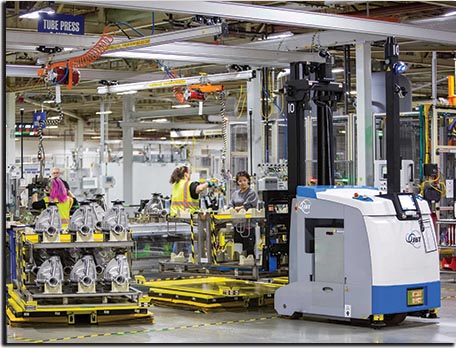
As expected, Wi-Fi systems figure prominently here. But there’s also the matter of the Internet of Things (IoT). This will be extremely interesting to watch as predictive maintenance advances. Some say the IoT will be too costly for automotive. But what’s the cost of an unexpected line stoppage due to a maintenance failure? Probably more than the cost of IoT infrastructure on materials handling and other types of equipment.
Looking even further out into the future, Suero talks about 3D printing. No, he’s not calling for 3D printing of entire cars. Instead, he’s looking to 3D printing as a key developmental technology to expedite matching equipment, especially robots with grippers, to handling specific parts. “3D allows suppliers to shorten the time needed to design equipment that most efficiently handles parts. It will also improve the actual handling of parts on the line,” Suero says.
Companies mentioned in this article:

Article Topics
Automation News & Resources
Walmart chooses Swisslog AS/RS and software for third milk processing facility Lucas Watson appointed CSO for Körber’s Parcel Logistics business in North America 60 Seconds with Bob Trebilcock, outgoing executive editor, Modern Materials Handling Kathleen Phelps to join FORTNA as chief financial officer Coles automates grocery distribution in Australia 2024 Intralogistics Robotics Survey: Robot demand surges Warehouse automation extends life of cheese DC by a decade More AutomationLatest in Materials Handling
Registration open for Pack Expo International 2024 Walmart chooses Swisslog AS/RS and software for third milk processing facility NetLogistik partners with Vuzix subsidiary Moviynt to offer mobility solutions for warehouses Materials Handling Robotics: The new world of heterogeneous robotic integration BSLBATT is looking for new distributors and resellers worldwide Lucas Watson appointed CSO for Körber’s Parcel Logistics business in North America Hyster recognizes Dealers of Distinction for 2023 More Materials HandlingSubscribe to Materials Handling Magazine

Find out what the world's most innovative companies are doing to improve productivity in their plants and distribution centers.
Start your FREE subscription today.
April 2024 Modern Materials Handling

Latest Resources


